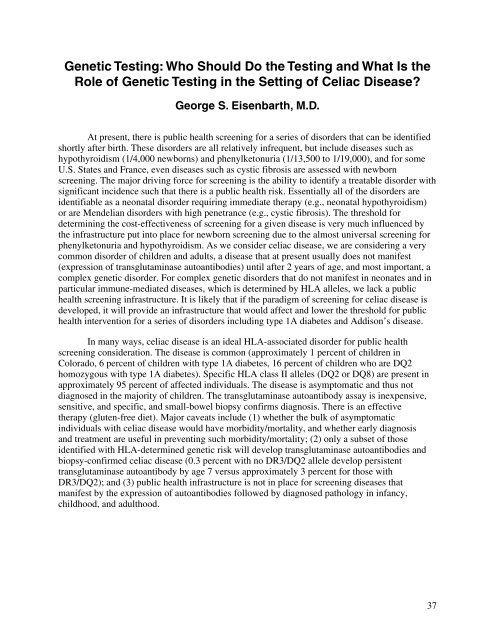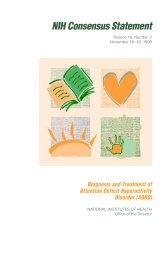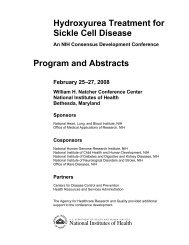Celiac Disease - NIH Consensus Development Program - National ...
Celiac Disease - NIH Consensus Development Program - National ...
Celiac Disease - NIH Consensus Development Program - National ...
Create successful ePaper yourself
Turn your PDF publications into a flip-book with our unique Google optimized e-Paper software.
Genetic Testing: Who Should Do the Testing and What Is theRole of Genetic Testing in the Setting of <strong>Celiac</strong> <strong>Disease</strong>?George S. Eisenbarth, M.D.At present, there is public health screening for a series of disorders that can be identifiedshortly after birth. These disorders are all relatively infrequent, but include diseases such ashypothyroidism (1/4,000 newborns) and phenylketonuria (1/13,500 to 1/19,000), and for someU.S. States and France, even diseases such as cystic fibrosis are assessed with newbornscreening. The major driving force for screening is the ability to identify a treatable disorder withsignificant incidence such that there is a public health risk. Essentially all of the disorders areidentifiable as a neonatal disorder requiring immediate therapy (e.g., neonatal hypothyroidism)or are Mendelian disorders with high penetrance (e.g., cystic fibrosis). The threshold fordetermining the cost-effectiveness of screening for a given disease is very much influenced bythe infrastructure put into place for newborn screening due to the almost universal screening forphenylketonuria and hypothyroidism. As we consider celiac disease, we are considering a verycommon disorder of children and adults, a disease that at present usually does not manifest(expression of transglutaminase autoantibodies) until after 2 years of age, and most important, acomplex genetic disorder. For complex genetic disorders that do not manifest in neonates and inparticular immune-mediated diseases, which is determined by HLA alleles, we lack a publichealth screening infrastructure. It is likely that if the paradigm of screening for celiac disease isdeveloped, it will provide an infrastructure that would affect and lower the threshold for publichealth intervention for a series of disorders including type 1A diabetes and Addison’s disease.In many ways, celiac disease is an ideal HLA-associated disorder for public healthscreening consideration. The disease is common (approximately 1 percent of children inColorado, 6 percent of children with type 1A diabetes, 16 percent of children who are DQ2homozygous with type 1A diabetes). Specific HLA class II alleles (DQ2 or DQ8) are present inapproximately 95 percent of affected individuals. The disease is asymptomatic and thus notdiagnosed in the majority of children. The transglutaminase autoantibody assay is inexpensive,sensitive, and specific, and small-bowel biopsy confirms diagnosis. There is an effectivetherapy (gluten-free diet). Major caveats include (1) whether the bulk of asymptomaticindividuals with celiac disease would have morbidity/mortality, and whether early diagnosisand treatment are useful in preventing such morbidity/mortality; (2) only a subset of thoseidentified with HLA-determined genetic risk will develop transglutaminase autoantibodies andbiopsy-confirmed celiac disease (0.3 percent with no DR3/DQ2 allele develop persistenttransglutaminase autoantibody by age 7 versus approximately 3 percent for those withDR3/DQ2); and (3) public health infrastructure is not in place for screening diseases thatmanifest by the expression of autoantibodies followed by diagnosed pathology in infancy,childhood, and adulthood.37







